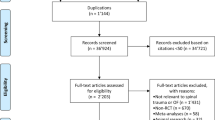Abstract
Summary
This paper presents a multi-method research project to develop a conceptual framework for measuring outcomes in studies of osteoporotic kyphosis. The research involved literature research and qualitative interviews among clinicians who treat patients with kyphosis and among patients with the condition.
Introduction
Kyphosis due to at least one vertebral compression fracture is prevalent among osteoporotic patients, resulting in well-documented symptoms and impact on functioning and well-being. A three-part study led to development of a conceptual measurement framework for comprehensive assessment of symptoms, impact, and treatment benefit for kyphosis.
Methods
A literature-based disease model (DM) was developed and tested with physicians (n = 10) and patients (n = 10), and FDA guidelines were used to develop a final disease model and a conceptual framework.
Results
The DM included signs, symptoms, causes/triggers, exacerbations, and functional status associated with kyphosis. The DM was largely confirmed, but physicians and patients added several concepts related to impact on functioning, and some concepts were not confirmed and removed from the DM.
Conclusions
This study confirms the need for more comprehensive assessment of health outcomes in kyphosis, as most current studies omit key concepts.



Similar content being viewed by others
References
Patrick DL, Burke LB, Powers JH, Scott JA, Rock EP, Dawisha S, O'Neill R, Kennedy DL (2007) Patient-reported outcomes to support medical product labeling claims: FDA perspective. Value Health 10(Suppl 2):S125–S137
Patrick DL, Burke LB, Gwaltney CJ, Kline Leidy N, Martin ML, Molsen E, Ring L (2011) Content validity establishing and reporting the evidence in newly developed patient-reported outcomes (PRO) instruments for medical product evaluation: ISPOR PRO good research practices task force report: part 2—assessing respondent understanding. Value Health 14:978–988
Patrick DL, Burke LB, Gwaltney CJ, Kline Leidy N, Martin ML, Molsen E, Ring L (2011) Content validity establishing and reporting the evidence in newly developed patient-reported outcomes (PRO) instruments for medical product evaluation: ISPOR PRO good research practices task force report: part 1—eliciting concepts for a new pro instrument. Value Health 14:967–977
Food and Drug Administration (2009) Guidance for industry, patient-reported outcome measures: use in medical product development to support labeling claims. U.S. Department of Health and Human Services
Burke LB, Kennedy DL, Miskala PH, Papadopoulos EJ, Trentacosti AM (2008) The use of patient-reported outcome measures in the evaluation of medical products for regulatory approval. Clin Pharmacol Ther 84:281–283
Rothman ML, Beltran P, Cappelleri JC, Lipscomb J, Teschendorf B (2007) Patient-reported outcomes: conceptual issues. Value Health 10(Suppl 2):S66–S75
Culham EG, Jimenez HA, King CE (1994) Thoracic kyphosis, rib mobility, and lung volumes in normal women and women with osteoporosis. Spine (Phila Pa 1976) 19:1250–1255
Kado DM, Browner WS, Palermo L, Nevitt MC, Genant HK, Cummings SR (1999) Vertebral fractures and mortality in older women: a prospective study. Study of osteoporotic fractures research group. Arch Intern Med 159:1215–1220
Miyakoshi N, Kasukawa Y, Sasaki H, Kamo K, Shimada Y (2009) Impact of spinal kyphosis on gastroesophageal reflux disease symptoms in patients with osteoporosis. Osteoporos Int 20:1193–1198
Pluijm SM, Tromp AM, Smit JH, Deeg DJ, Lips P (2000) Consequences of vertebral deformities in older men and women. J Bone Miner Res 15:1564–1572
Rao RD, Singrakhia MD (2003) Painful osteoporotic vertebral fracture. Pathogenesis, evaluation, and roles of vertebroplasty and kyphoplasty in its management. J Bone Jt Surg Am 85-A:2010–2022
Sclaich C, Minne HW, Bruckner T et al (1998) Reduced pulmonary function in patients with spinal osteoporotic fractures. Osteoporos Int 8:1–7
Silverman SL (1992) The clinical consequences of vertebral compression fracture. Bone 13(Suppl 2):S27–S31
Sinaki M (2007) The role of physical activity in bone health: a new hypothesis to reduce risk of vertebral fracture. Phys Med Rehabil Clin N Am 18:593–608
Sinaki M, Pfeifer M, Preisinger E, Itoi E, Rizzoli R, Boonen S, Geusens P, Minne HW (2010) The role of exercise in the treatment of osteoporosis. Curr Osteoporos Rep 8:138–144
Yamaguchi T, Sugimoto T, Yamauchi M, Matsumori Y, Tsutsumi M, Chihara K (2005) Multiple vertebral fractures are associated with refractory reflux esophagitis in postmenopausal women. J Bone Miner Metab 23:36–40
Centre for Health Evidence (2006) Evidence-based medicine informatics project
Glaser B, Strauss AL (1967) The constant comparative methods of qualitative analysis. Discovery of grounded theory. 101–16
Lincoln YS, Guba EG (1985) Designing a naturalistic inquiry. Naturalistic inquiry. 221–49
Wilson IB, Cleary PD (1995) Linking clinical variables with health-related quality of life. A conceptual model of patient outcomes. JAMA 273:59–65
Conflicts of interest
Carolin Miltenburger and Luisa Alvares are employed by Medtronic Spinal & Biologics, which funded this research. Martha Bayliss and Michelle White are employed by QualityMetric, which has served as a consultant to Medtronic.
Author information
Authors and Affiliations
Corresponding author
Rights and permissions
About this article
Cite this article
Bayliss, M., Miltenburger, C., White, M. et al. A conceptual and disease model framework for osteoporotic kyphosis. Osteoporos Int 24, 2423–2432 (2013). https://doi.org/10.1007/s00198-013-2317-6
Received:
Accepted:
Published:
Issue Date:
DOI: https://doi.org/10.1007/s00198-013-2317-6




